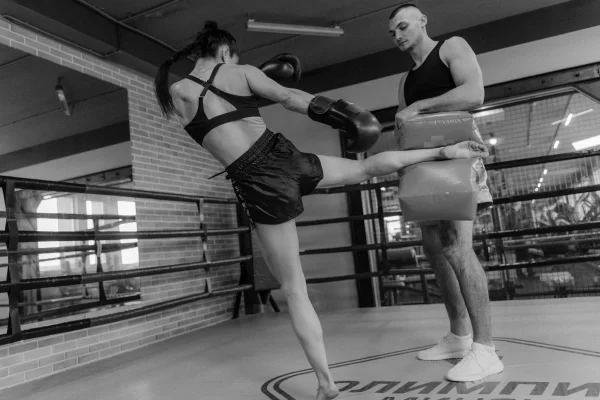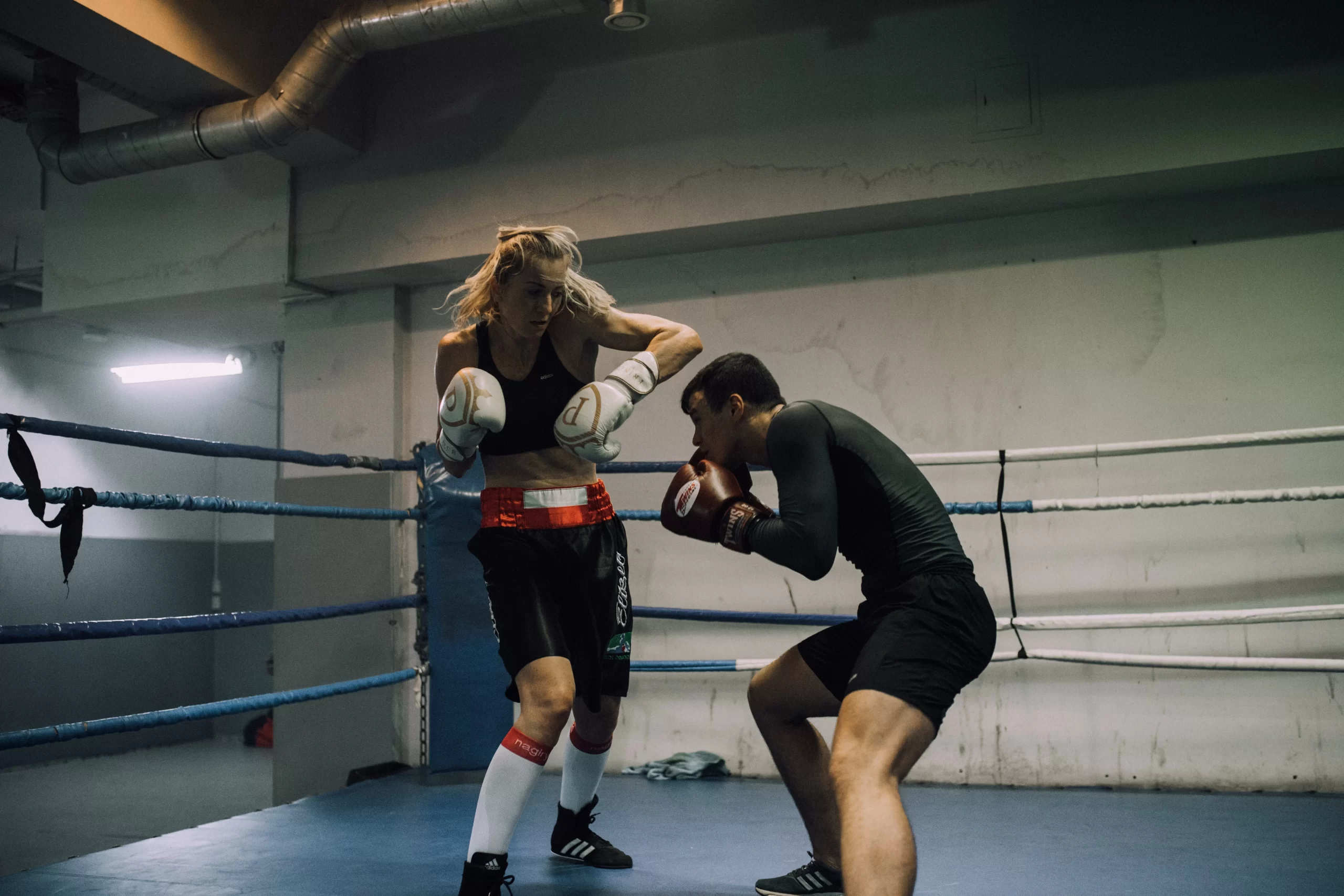
In boxing, footwork has often been a key aspect of the sport. Boxing footwork importance cannot be overemphasized as it forms the basis of effective technique, defensive ability and strategic positioning.
In this article, we’ll explore the key reasons why footwork is so important in boxing, and how it can improve your performance in the ring.
Boxing Footwork Importance
Understanding and mastering boxing footwork is an important foundation for every aspiring boxer. By defining the role of footwork in boxing technique and recognizing its connection to balance and stability, you can take your game to new heights.
Understanding Boxing Footwork: An Essential Element

Boxing footwork is the basic dance that sets the tempo and tone of every fight. It is the art of moving the feet with deftness and precision, which plays a pivotal role in all aspects of boxing technique.
Imagine a graceful boxer swinging darts in the ring, avoiding punches effortlessly while delivering sharp and powerful blows. This is the magic of boxing footwork.
The Definition of Boxing Footwork and Its Role in Boxing Technique
At its core, boxing footwork refers to how a boxer moves in the ring—foot position, weight distribution, and seamless transitions from one stance to another. It’s not just about fancy footwork; it’s about mastering the basic foot movements that allow a boxer to attack and defend strategically.
Proper footwork is essential for balance and stability, ensuring a solid foundation for all punching and defensive moves. Whether you’re delivering a lightning-fast jab or a well-timed turn to avoid an incoming uppercut, your footwork determines your success.
The Intricate Link Between Footwork, Balance, And Stability
Think of boxing footwork as the glue that holds the entire game plan together. The way your feet are positioned affects your balance and stability, which in turn affects your punching power and ability to defend.
When your feet are in the right position, you maintain better balance and allow you to generate more power when you punch. Imagine keeping your feet firmly planted before delivering a devastating right pass – that’s where your knockout potential comes in.
Stability is equally important, especially during intense moments when you need to defend against fist onslaughts. A stable posture allows you to stay on your feet even when you take a hard hit, reducing the chance of losing your balance.
Additionally, footwork allows for a seamless transition between offense and defense. As you move, spin, and circle around your opponent, you can set yourself up with vantage points to attack or dodge incoming shots. Boxers with great footwork can dominate the flow of a fight and control the distance, making them formidable opponents.
Practice precision and finesse in your footwork, and you’ll find yourself gliding with confidence and grace around the ring, ready to outwit and crush your opponents. Remember, boxing footwork isn’t just a technique or skill. It’s the heart and soul of every successful boxer’s style.
Enhancing Agility and Speed: Unleashing the Power of Quick Feet in Boxing

In boxing, agility and speed play a vital role in outwitting opponents and seizing opportunities in the ring. The ability to move quickly and easily is a key aspect of footwork that not only enhances defense but also increases the speed and accuracy of punches.
In this section, we’ll dive into the importance of developing agile footwork, the relationship between footwork and hand speed, and effective agility training to enhance your footwork abilities.
Develop Agile Footwork: Evasive Maneuvers and Quick Counterattacks
In boxing, agile footwork allows you to dodge incoming punches and strike back quickly. By mastering complex footwork such as side steps, spins and angle changes, you can effortlessly maneuver around your opponents, minimizing your chances of getting hit.
The key is to keep your footwork light and flexible, allowing you to quickly adjust your position to your opponent’s movements.
Relationship Between Footwork and Hand Speed
Footwork and hand speed are intertwined in the art of boxing. Efficient footwork not only allows you to get the best punch placement, but also allows you to generate more power and speed when striking.
When your footwork is solid, you can effectively transfer weight from your legs to your punch, delivering lightning-fast strikes with precision. Synchronization between footwork and hand speed is critical to executing fluid combinations and catching opponents off guard.
Agility Drills and Exercises to Improve Footwork
To enhance your agility and footwork, it’s crucial to incorporate specific exercises into your routine. The agility ladder drill involves using quick foot movements to traverse the rungs of a ladder, which improves foot coordination and reaction time.
Cone drills involve quick changes of direction and quick sprints, which help develop explosive movement and the ability to maintain balance. Additionally, shadow boxing, which focuses on footwork, allows you to simulate real combat scenarios and fine-tune your movement patterns.
By consistently practicing these agility drills, you can improve your footwork skills, sharpen your reflexes, and become better at maneuvering quickly in the ring. Remember, agility and speed aren’t just about physical fitness. They can be honed through dedicated training and ongoing practice.
Developing agile footwork is a game changer in the world of boxing. It enables you to deftly dodge punches, mount effective counterattacks, and increase your own attack speed and strength.
By understanding the critical relationship between footwork and hand speed, you can optimize your performance in the ring. Make agility drills and exercises an integral part of your training regimen and witness a transformation in your footwork abilities. With quick feet and lightning reflexes, you’ll gain a significant advantage over your opponents, allowing you to navigate the ring with precision, speed, and deftness.
Establishing the Right Position and Angle: Dominating the Ring

In the dynamic world of boxing, establishing the correct position and angle is a vital skill that can give you a significant advantage over your opponent. It involves creating strategic angles for offense and defense, using footwork to control distance, and determining the tempo of a fight.
Let’s delve into this aspect of boxing footwork and explore its importance in dominating the ring.
Create Offensive and Defensive Angles
One of the key elements of boxing footwork is the ability to create angles. By moving your feet strategically, you can adjust your position so you can mount an effective attack and defend against your opponent’s punches. Creating angles allows you to target your opponent’s weak spots, increasing your chances of delivering powerful and accurate punches.
Whether walking sideways, turning around, or circling an opponent, the art of creating angles through footwork is an essential skill that can greatly enhance your offensive and defensive abilities.
Advantages of Correct Positioning in Attack, Defense and Counterattack
Proper positioning in boxing is crucial for a number of reasons. First, it allows you to maximize the power and accuracy of your punches. When you position yourself correctly, you can generate more power through proper weight transfer, enabling you to deliver devastating blows.
Second, it boosts your defenses. By maintaining proper positioning, you can effectively block, slip, or dodge your opponent’s punches, minimizing your chances of getting hit and maximizing your defensive capabilities.
In addition, correct positioning also plays a vital role in the counterattack. When you’re at the right angle, you can take advantage of your opponent’s openings and launch a quick and precise counterattack. Not only does this catch your opponent off guard, but it also allows you to maintain control of the fight.
Use Footwork to Control the Distance and Dominate the Battle Rhythm
Footwork in boxing isn’t just about moving your feet. It’s about controlling the distance between you and your opponent.
By mastering footwork technique, you can effectively control the space in the ring, adjusting the distance to your advantage. This keeps you out of your opponent’s range, making it difficult for them to land clean punches, while giving you the opportunity to strike with precision.
Additionally, footwork plays a vital role in determining the tempo of a fight. You can use quick footwork to create a fast-paced and aggressive style, overwhelming your opponent with a barrage of punches. On the other hand, you can slow down by strategically moving around the ring, frustrating your opponents and disrupting their rhythm.
Establishing proper position and angles through footwork is critical to dominance in a boxing match. It enables you to create favorable angles for offense and defense, maximizing the power and accuracy of your punches while minimizing the risk of getting hit.
By using footwork effectively, you can control distance, dictate the tempo of the fight, and ultimately gain a significant advantage over your opponent. This is why professional boxers cannot ignore the boxing footwork importance.
So focus on honing your footwork skills, practice creating angles, and watch your performance soar and become a force to be reckoned with in the ring.
Defensive Mastery: The Elusive Art of Footwork

One of the key elements of a solid boxing defensive strategy is mastering the elusive art of footwork. By honing your footwork skills, you can effectively dodge punches, maintain your balance, and dodge your opponent’s strikes.
In this section, we’ll explore the various techniques and benefits of defensive footwork in boxing.
Dodge Punches with Lateral Movement and Rotation Techniques
One of the main goals of defensive footwork is to avoid incoming punches. This can be achieved with lateral movement and pivoting techniques. By stepping sideways or diagonally, you create angles that make it difficult for your opponent to hit the ball cleanly. Lateral movement moves you away from your opponent’s immediate line of attack, forcing them to reposition and giving you the advantage.
The spinning technique is another effective way to dodge punches. By rotating your body around your front or rear foot, you can quickly change angles and make yourself a moving target. Spinning allows you to slide out of attack range while throwing your opponent off balance and creating an opportunity for a counterattack.
Slips, Weaves and Swings and Their Connection to Footwork
Sliding, weaving and swinging are all defensive moves closely related to footwork. These techniques involve subtle head movements combined with coordinated footwork to dodge punches. By utilizing precise footwork patterns, you can effectively dodge punches by moving your head and body out of harm’s way.
Slipping involves moving your head sideways while transferring your weight to the corresponding foot. This allows you to dodge a few inches of punch and keep your opponent swinging in the air. Swinging involves lateral footwork, which involves moving the head in a swinging motion while transferring weight from one foot to the other. This technique creates an elusive target that makes it difficult for your opponent to make a clean shot.
The shake is another defensive move that requires coordinated footwork. It involves bending the knees and rhythmically moving the upper body up and down while deftly shifting weight between the feet. This move changes your level, making it harder for your opponent to land hard hits, thus helping you dodge punches.
The Importance of Footwork to Maintain Balance and Avoid Attacks
Maintaining balance is crucial in boxing, especially when performing defensive moves. Proper footwork allows you to maintain a solid base and quickly transition between offensive and defensive positions. It enables you to move smoothly and quickly, ensuring you stay balanced while dodging punches.
Footwork also plays a vital role in countering your opponent’s attacks. By maintaining balance and proper positioning, you can quickly capitalize on their missed punches and strike back with precision.
Defensive skill in boxing relies heavily on the elusive art of footwork. By implementing lateral moves, pivoting techniques, sliding, weaving and swinging, you can effectively dodge punches and minimize your opponent’s chances of hitting clean shots.
Additionally, footwork is critical to maintaining balance, allowing you to quickly switch between defensive and offensive positions. By investing time and practice in mastering defensive footwork, you’ll improve your overall defensive skills and become a stronger boxer in the ring.
Maximizing Power and Generating Punching Opportunities

For boxing, maximizing power and creating punches are critical skills that can make all the difference in the ring.
In this section, we’ll explore how proper weight transfer and synchronized footwork play a key role in generating power, creating openings, and building effective sets.
Power Generation Through Proper Weight Transfer and Footwork Synchronization
One of the key factors in generating power when punching is transferring weight from the back foot to the front foot. This movement, called weight transfer, allows you to generate power and deliver powerful strikes. It is important to synchronize the weight transfer with the footwork to maximize the impact of the punch.
Imagine yourself throwing a straight right. As you extend your arms, simultaneously transfer weight from the back foot to the front foot. This weight shift increases the momentum and power of the punch, increasing its effectiveness.
By practicing proper weight shift combined with footwork, you’ll be able to generate more power when you throw your punches and increase your chances of hitting hard hits.
Footwork Techniques to Create Space and Exploit the Opponent’s Weaknesses
Footwork in boxing isn’t just about moving in the ring. It also involves creating opportunities to attack and exploit an opponent’s weaknesses. By using a variety of footwork techniques, you can create openings in your opponent’s defense and exploit their weaknesses.
One effective technique is called “feinting.” This involves using subtle footwork to trick opponents into reacting or opening up their defense. For example, you can fake a step forward with your front foot to elicit a reaction from your opponent, then quickly step back and counter with a powerful punch.
Another technique is called “angle cutting”. By using quick and precise footwork, you can create angles that allow you to strike from different positions, making it harder for your opponent to defend against your punches. A lateral move or a spin with your feet can help you create these angles and catch your opponent off guard.
The Role of Footwork in Establishing Effective Combinations
Footwork helps to build and execute effective combinations. By using the correct footwork, you can position yourself at the optimal range and angle to seamlessly deliver a series of punches.
For example, let’s say you want to hit the classic one-two combo, which includes a jab and a cross. To execute this combo effectively, you need to step your front foot forward when you jab, then turn your back foot when you deliver the cross. This coordinated footwork ensures your punches flow smoothly and generate maximum power.
Mastering footwork technique is critical to maximizing power, creating space and building effective combinations in boxing. By focusing on proper weight transfer, synchronization of footwork and punching, and employing various footwork techniques, you can improve your overall performance in the ring.
So take the time to practice and perfect your footwork technique, and you’ll soon notice a difference in your power, precision, and ability to catch your punches.
Conditioning and Endurance: Building Stamina Through Footwork

Stamina is a key factor in determining a boxer’s performance in a boxing match. The ability to maintain energy and stamina throughout a fight is critical to maintaining distance and executing effective technique. This is where footwork comes into play.
By incorporating specific footwork drills and exercises into your routine, you can improve your stamina and build the endurance you need to excel in the ring.
Footwork Drills and Exercises to Improve Stamina
An effective footwork exercise for building endurance is the “ladder exercise.” Set up an agility ladder on the floor and practice quick footwork by getting in and out of each ladder block as quickly as possible. Not only will this exercise improve foot speed and coordination, it will also help tone your legs and improve overall stamina.
Another valuable exercise for building stamina is the “shadow boxing footwork.” This involves moving around the training area while delivering the punch and focusing on maintaining proper footwork technique.
Start with slow, deliberate movements and gradually increase the speed as you feel more comfortable. This exercise simulates the footwork demands of real combat, helping you build stamina while executing various boxing combinations.
Boxing Footwork Importance for Maintaining Energy Throughout the Fight
Footwork is fundamental to maintaining energy and conserving stamina in combat. By moving efficiently and effectively, you minimize wasted energy and maintain control of your rhythm.
A key aspect of footwork related to endurance is foot position. As you move, strive to maintain a balanced posture, distributing your weight evenly between your feet. This allows for rapid rotation and movement, reduces muscle stress and helps you conserve energy.
Additionally, footwork can be used strategically to control the distance between you and your opponent. By maintaining the best position, you can keep your opponents at bay, reducing your chances of getting hit while conserving energy.
Mastering footwork skills such as “sliding step” and “pivot step” can help you quickly adjust your position and stay one step ahead of your opponent.
Remember that building endurance through footwork takes time and consistent practice. Gradually increase the intensity and duration of your footwork drills and exercises to challenge yourself and push your limits. Incorporating it with aerobic exercise such as jumping rope or running can further enhance your overall stamina.
Physical fitness and stamina are key elements of boxing. By focusing on footwork exercises and exercises that improve endurance, you can improve your performance in the ring.
Develop quick footwork, practice shadow boxing routines, and prioritize proper foot placement to build your stamina and maintain energy throughout a fight. With dedication and perseverance, you’ll find that you can hold out longer, move more efficiently, and pack powerful punches with unwavering stamina.
Mastering Footwork Techniques: Tips and Training Strategies

Mastering the art of footwork is essential to truly excel in boxing. Effective footwork gives you an edge in the ring, allowing you to move flexibly, maintain your balance, and create opportunities for your punches. In this section, we’ll explore some valuable tips and training strategies to help you develop impeccable footwork skills.
Develop Core Strength and Stability to Enhance Footwork
Building a strong and stable core is the foundation of great footwork. Your core muscles provide the stability and strength needed to perform quick, precise movements. Incorporate exercises like planks, Russian twists and medicine ball spins into your routine to strengthen your core. By strengthening your core, you’ll improve your overall balance and control, allowing you to move quickly and efficiently.
Shadow Boxing Practice to Perfect Footwork Technique
Shadow boxing is an excellent way to fine-tune your footwork technique. This individual training method allows you to focus on your own movements without interference from your opponent. Start by practicing basic footwork patterns, such as forward and backward moves, side steps, and spins.
Visualize the opponent in front of you and execute your footwork with precision and fluidity. As you become more proficient, challenge yourself by incorporating defensive moves and complex footwork combinations. Remember to maintain proper posture and foot position throughout your shadow boxing training.
Apply Footwork Techniques in A Dynamic Environment with Practice and Sparring Exercises
Partner drills and sparring exercises are invaluable for translating your footwork skills into dynamic and realistic boxing scenarios. Work with a training partner or coach on various footwork techniques while having controlled boxing exchanges.
Start with basic partner exercises, such as mirrored footwork, where you mimic each other’s movements. Gradually progress to more advanced training, including defensive maneuvers and counterattacks. These exercises will not only improve your footwork, but also your quick reflexes and ability to adapt to different boxing styles.
Sparring is the ultimate test of your footwork skills. They allow you to apply footwork techniques in dynamic and unpredictable environments. Focus on maintaining proper distance, using angles and keeping your feet light. Pay attention to your partner’s movements and adjust your footwork accordingly.
With consistent practice and feedback from a sparring partner or coach, you’ll refine your footwork and execute it more proficiently in actual competition.
Remember, mastering footwork is an ongoing process that requires dedication, practice, and attention to detail. If you are a beginner focus on developing core strength with best free standing punching bag, perfect your technique with shadow boxing exercises, and learn about footwork drills.
By incorporating these tips and training strategies into your routine, you’ll gradually strengthen your footwork and improve your overall boxing performance. Rise to the challenge, maintain discipline, and enjoy a rewarding journey to master boxing footwork.
The Psychological Impact of Footwork in Boxing

Footwork not only affects physical performance, it also has a profound effect on the mind. The way you move your feet in the ring can boost your confidence, improve your mental focus, and increase your resilience.
In this section, we’ll explore how footwork can affect your state of mind, strengthen your mind-body connection, and help you overcome challenges.
Build Confidence Through Graceful Footwork
When your footwork is graceful and precise, it can have a transformative effect on your confidence in the ring. Every quick step and nimble pivot brings a sense of control and mastery to your movements, giving you confidence that you can outsmart and outmaneuver your opponents.
As you practice and perfect your footwork, you’ll witness your confidence soar, enabling you to execute strategies with firmness and poise.
The Mind-Body Connection When Performing Precise Footwork Patterns
Footwork in boxing requires a strong mind-body connection. The complex gait patterns you execute are the result of your mental focus and physical coordination. When you train and internalize these patterns, your brain adapts to the movements, allowing you to perform them instinctively.
This connection between your mind and body not only improves your overall performance, but also deepens your understanding of the sport, making you a more intuitive and adaptable boxer.
Overcoming Footwork Challenges and Building Resilience
Footwork in boxing presents various challenges such as coordination issues, timing difficulties, and adapting to different styles of opponents. However, these challenges also present valuable opportunities for psychological growth and resilience.
When you encounter obstacles on your footwork journey, you learn to adapt, persevere, and find creative solutions. Overcoming these challenges builds mental resilience and gives you the confidence that you can overcome any obstacle in or out of the ring.
Incorporating footwork exercises into your training regimen is an effective way to develop mental resilience. Overcoming fatigue, staying focused during intense footwork sessions, and constantly striving to improve all contribute to a strong and disciplined mindset.
As you watch your footwork skills improve, you’ll develop a fortitude that goes beyond boxing and positively impacts every area of your life.
Footwork has a profound psychological effect on the mindset of a boxer. Through graceful footwork, you can develop confidence and control in the ring. The mind-body connection established through footwork patterns allows you to execute movements with precision and instinct.
By overcoming footwork challenges, you build mental resilience, which translates into a resilient mindset in every area of your life. Embrace the spiritual side of footwork and you’ll discover its power in unleashing your inner champion. Continuously perfect your footwork techniques, develop your mental fitness, and see your boxing prowess and mental stamina reach new heights.
Conclusion
Boxing footwork is the cornerstone of a successful boxer’s skills. From agility and speed to positioning and defensive ability, mastering footwork can improve every aspect of your performance in the ring.
Invest time and effort in developing your footwork technique, incorporating targeted drills and exercises into your training regimen. By understanding the boxing footwork importance and honing your skills, you’ll gain a distinct advantage, allowing you to move with grace, precision and confidence, ultimately taking your boxing game to new heights.
Learn more about boxing footwork importance by watching the following video;
